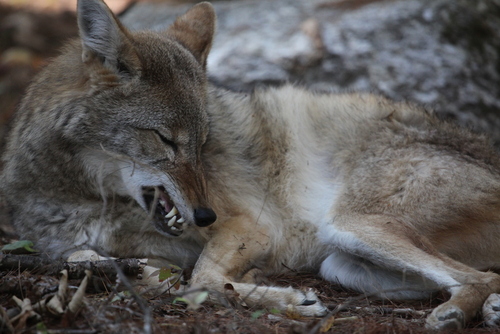
| common name | Coyote |
| Also called | prairie wolf, wild dog |
| scientific name | Canis latrans |
| classification | Animalia - Chordata - Mammalia - Carnivora - Canidae |
| hazard type | man-eater, food thief |
| range & frequency | common throughout the Northeast. |
Coyotes are versatile, clever animals. They hunt at night or during the day, alone or in packs, eating anything they can catch, from mice to deer (also some plants and insects). Their usual staple is rodents, but they won't turn up their noses at garbage, and they seem to relish cats and small dogs. In other words, coyotes are quite comfortable living in close proximity to humans - including in Central Park.
It's a bit surprising, then, that the population of coyote in the eastern U.S. is quite recent. New Hampshire had no coyote sightings before 1944, and much of the state remained coyote-free into the 1970s. All coyotes in the East seem to be more closely related to each other than to Western coyotes. The founders of the Eastern population are thought to have traveled east via Canada, interbreeding with wolves somewhere along the way. That dose of wolf blood may help explain why Eastern coyotes are much larger than their Western relatives.
There is no question that coyotes are large enough and organized enough to hunt a human. (Humans would be easy compared to deer.) Reports of coyotes biting adult humans are surprisingly rare (about one a year nationwide, mostly in California), and usually involve attacks on pets in which the human leaps to the rescue. There have been several incidents in California in which coyotes attacked small children. These followed a pattern of gradually more brazen coyote behavior, in which coyotes became more active in daylight, entered fenced yards, and snatched pets off leashes. New York State has reported the beginnings of a similar pattern, but so far the coyotes in New England remain fearful of humans.
Avoid sticking your head into a likely coyote den.
Do not feed coyotes. Do not leave food (especially meat) out for pets or other animals, as you are likely to feed coyote instead.
Keep small pets and small children in close proximity.
If bitten by a coyote (or any wild animal), rabies should be suspected. Vaccine is ineffective unless administered promptly (within a day or so) and the disease is fatal, so seek medical attention at once.
U. of Michigan Animal Diversity Web: Coyote
National Geographic News: Are Coyotes Becoming more Agressive?